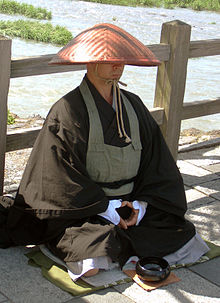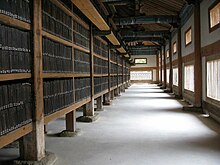User:Furthershore/sandbox/Introduction to Buddhist Texts
Theravada school
[edit]The name Theravāda comes from the Sthaviras, from which the Theravadins claim descent. The Second Buddhist council resulted in the first schism in the Sangha, probably caused by a group of reformists called Sthaviras who split from the conservative majority Mahāsāṃghikas.[1] After unsuccessfully trying to modify the Vinaya, a small group of "elderly members", i.e. sthaviras, broke away from the majority Mahāsāṃghika during the Second Buddhist council, giving rise to the Sthavira sect.[2] Sinhalese Buddhist reformers in the late nineteenth and early twentieth centuries portrayed the Pali Canon as the original version of scripture.[3] They also emphasized Theravada being rational and scientific.[3]
Theravāda is primarily practiced today in Sri Lanka, Burma, Laos, Thailand, Cambodia as well as small portions of China, Vietnam, Malaysia and Bangladesh. It has a growing presence in the west.
Theravadin Buddhists believe that personal effort is required to realize rebirth. Monks follow the vinaya: meditating, teaching and serving their lay communities. Laypersons can perform good actions, producing merit.[4]
Pāli Tipitaka
[edit]| Pāli Canon |
|---|
 |
| Theravāda Buddhism |
The Pāli Tipitaka, which means "three baskets", refers to the Vinaya Pitaka, the Sutta Pitaka, and the Abhidhamma Pitaka. The Vinaya Pitaka contains disciplinary rules for the Buddhist monks and nuns, as well as explanations of why and how these rules were instituted, supporting material, and doctrinal clarification. The Sutta Pitaka contains discourses ascribed to Gautama Buddha. The Abhidhamma Pitaka contains material often described as systematic expositions of the Gautama Buddha's teachings.
The Pāli Tipitaka is the only early Tipitaka (Sanskrit: Tripiṭaka) to survive intact in its original language, but a number of early schools had their own recensions of the Tipitaka featuring much of the same material. We have portions of the Tipitakas of the Sārvāstivāda, Dharmaguptaka, Sammitya, Mahāsaṅghika, Kāśyapīya, and Mahīśāsaka schools, most of which survive in Chinese translation only. According to some sources, some early schools of Buddhism had five or seven pitakas.[5]
According to the scriptures, soon after the death of the Buddha, the first Buddhist council was held; a monk named Mahākāśyapa (Pāli: Mahākassapa) presided. The goal of the council was to record the Buddha's teachings. Upāli recited the vinaya. Ānanda, the Buddha's personal attendant, was called upon to recite the dhamma. These became the basis of the Tripitaka. However, this record was initially transmitted orally in form of chanting, and was committed to text in the last century BCE. Both the sūtras and the vinaya of every Buddhist school contain a wide variety of elements including discourses on the Dharma, commentaries on other teachings, cosmological and cosmogonical texts, stories of the Gautama Buddha's previous lives, and various other subjects.
Much of the material in the Canon is not specifically "Theravadin", but is instead the collection of teachings that this school preserved from the early, non-sectarian body of teachings. According to Peter Harvey, it contains material at odds with later Theravadin orthodoxy. He states: "The Theravadins, then, may have added texts to the Canon for some time, but they do not appear to have tampered with what they already had from an earlier period."[6]
Mahayana traditions
[edit]
Mahayana Buddhism flourished in India from the 5th century CE onwards, during the dynasty of the Guptas. Mahāyāna centres of learning were established, the most important one being the Nālandā University in north-eastern India.
Mahayana schools recognize all or part of the Mahayana Sutras. Some of these sutras became for Mahayanists a manifestation of the Buddha himself, and faith in and veneration of those texts are stated in some sutras (e.g. the Lotus Sutra and the Mahaparinirvana Sutra) to lay the foundations for the later attainment of Buddhahood itself.

Native Mahayana Buddhism is practiced today in China, Japan, Korea, Singapore, parts of Russia and most of Vietnam (also commonly referred to as "Eastern Buddhism"). The Buddhism practiced in Tibet, the Himalayan regions, and Mongolia is also Mahayana in origin, but is discussed below under the heading of Vajrayana (also commonly referred to as "Northern Buddhism"). There are a variety of strands in Eastern Buddhism, of which "the Pure Land school of Mahayana is the most widely practised today.".[7] In most of this area however, they are fused into a single unified form of Buddhism. In Japan in particular, they form separate denominations with the five major ones being: Nichiren, peculiar to Japan; Pure Land; Shingon, a form of Vajrayana; Tendai, and Zen. In Korea, nearly all Buddhists belong to the Chogye school, which is officially Son (Zen), but with substantial elements from other traditions.[8]
Mahayana sutras
[edit]
The Mahayana sutras are a very broad genre of Buddhist scriptures that the Mahayana Buddhist tradition holds are original teachings of the Buddha. Some adherents of Mahayana accept both the early teachings (including in this the Sarvastivada Abhidharma, which was criticized by Nagarjuna and is in fact opposed to early Buddhist thought)[9] and the Mahayana sutras as authentic teachings of Gautama Buddha, and claim they were designed for different types of persons and different levels of spiritual understanding.
The Mahayana sutras often claim to articulate the Buddha's deeper, more advanced doctrines, reserved for those who follow the bodhisattva path. That path is explained as being built upon the motivation to liberate all living beings from unhappiness. Hence the name Mahāyāna (lit., the Great Vehicle).
According to Mahayana tradition, the Mahayana sutras were transmitted in secret, came from other Buddhas or Bodhisattvas, or were preserved in non-human worlds because human beings at the time could not understand them:[10]
Some of our sources maintain the authenticity of certain other texts not found in the canons of these schools (the early schools). These texts are those held genuine by the later school, not one of the eighteen, which arrogated to itself the title of Mahayana, 'Great Vehicle'. According to the Mahayana historians these texts were admittedly unknown to the early schools of Buddhists. However, they had all been promulgated by the Buddha. [The Buddha's] followers on earth, the sravakas ('pupils'), had not been sufficiently advanced to understand them, and hence were not given them to remember, but they were taught to various supernatural beings and then preserved in such places as the Dragon World.
Approximately six hundred Mahayana sutras have survived in Sanskrit or in Chinese or Tibetan translations. In addition, East Asian Buddhism recognizes some sutras regarded by scholars as of Chinese rather than Indian origin.
Generally, scholars conclude that the Mahayana scriptures were composed from the 1st century CE onwards: "Large numbers of Mahayana sutras were being composed in the period between the beginning of the common era and the fifth century",[11] five centuries after the historical Gautama Buddha. Some of these had their roots in other scriptures composed in the 1st century BCE. It was not until after the 5th century CE that the Mahayana sutras started to influence the behavior of mainstream Buddhists in India: "But outside of texts, at least in India, at exactly the same period, very different—in fact seemingly older—ideas and aspirations appear to be motivating actual behavior, and old and established Hinnayana groups appear to be the only ones that are patronized and supported."[11] These texts were apparently not universally accepted among Indian Buddhists when they appeared; the pejorative label Hinayana was applied by Mahayana supporters to those who rejected the Mahayana sutras.
Only the Theravada school does not include the Mahayana scriptures in its canon. As the modern Theravada school is descended from a branch of Buddhism that diverged and established itself in Sri Lanka prior to the emergence of the Mahayana texts, debate exists as to whether the Theravada were historically included in the hinayana designation; in the modern era, this label is seen as derogatory, and is generally avoided.
Scholar Isabelle Onians asserts that although "the Mahāyāna ... very occasionally referred contemptuously to earlier Buddhism as the Hinayāna, the Inferior Way," "the preponderance of this name in the secondary literature is far out of proportion to occurrences in the Indian texts." She notes that the term Śrāvakayāna was "the more politically correct and much more usual" term used by Mahāyānists.[12] Jonathan Silk has argued that the term "Hinayana" was used to refer to whomever one wanted to criticize on any given occasion, and did not refer to any definite grouping of Buddhists.[13]
Vajrayana traditions
[edit]
Various classes of Vajrayana literature developed as a result of royal courts sponsoring both Buddhism and Saivism.[14] The Mañjusrimulakalpa, which later came to classified under Kriyatantra, states that mantras taught in the Saiva, Garuda and Vaisnava tantras will be effective if applied by Buddhists since they were all taught originally by Manjushri.[15] The Guhyasiddhi of Padmavajra, a work associated with the Guhyasamaja tradition, prescribes acting as a Saiva guru and initiating members into Saiva Siddhanta scriptures and mandalas.[16] The Samvara tantra texts adopted the pitha list from the Saiva text Tantrasadbhava, introducing a copying error where a deity was mistaken for a place.[17]
- ^ Harvey 2013, p. 89-90.
- ^ Skilton, Andrew. A Concise History of Buddhism. 2004. p. 49, 64
- ^ a b Samuel 2008, p. 16-17.
- ^ Hawkins 1999, pp. 88.
- ^ Skilling 1992, p. 114.
- ^ Harvey 1995, p. 9.
- ^ Clarke 2009, p. 86.
- ^ Buswell 2004, pp. 430, 435.
- ^ Kalupahana 1966, pp. 94–105.
- ^ Warder 2000, p. 4.
- ^ a b Buswell 2004, p. 494.
- ^ Onians 2001, p. 72.
- ^ Silk 2005, p. 335-405.
- ^ Sanderson, Alexis. "The Śaiva Age: The Rise and Dominance of Śaivism during the Early Medieval Period." In: Genesis and Development of Tantrism,edited by Shingo Einoo. Tokyo: Institute of Oriental Culture, University of Tokyo, 2009. Institute of Oriental Culture Special Series, 23, pp. 124.
- ^ Sanderson, Alexis. "The Śaiva Age: The Rise and Dominance of Śaivism during the Early Medieval Period." In: Genesis and Development of Tantrism,edited by Shingo Einoo. Tokyo: Institute of Oriental Culture, University of Tokyo, 2009. Institute of Oriental Culture Special Series, 23, pp. 129-131.
- ^ Sanderson, Alexis. "The Śaiva Age: The Rise and Dominance of Śaivism during the Early Medieval Period." In: Genesis and Development of Tantrism,edited by Shingo Einoo. Tokyo: Institute of Oriental Culture, University of Tokyo, 2009. Institute of Oriental Culture Special Series, 23, pp. 144-145.
- ^ Huber, Toni (2008). The holy land reborn : pilgrimage & the Tibetan reinvention of Buddhist India. Chicago: University of Chicago Press. pp. 94–95. ISBN 978-0-226-35648-8.
